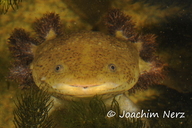|
Ambystoma dumerilii (Dugès, 1870)
Lake Pátzcuaro Salamander, Achoques Subgenus: Heterotriton | family: Ambystomatidae genus: Ambystoma |
| Species Description: Dugès, A. A. D. (1870). Una nueva especie de ajolote de la Laguna de Patzcuaro. La Naturaleza. México 1, 241–244. | |
 © 2014 Dr. Joachim Nerz (1 of 11) |
|
|
|
Description This animal is tan to brown and homogenous in coloration (Brandon 1992, Smith 1948). Distribution and Habitat Country distribution from AmphibiaWeb's database: Mexico
Life History, Abundance, Activity, and Special Behaviors Ova mature during the rainy seasons and spawning occurs with increasing atmospheric temperatures; breeding observed during winter (IUCN 2004) and spring (Brandon 1970). Salamanders feed by suction and sport distinguishably few “tooth-like rakers” as described above (IUCN 2004) - laboratory animals thrive on beef liver (Brandon 1970). Argulus ambystoma, a new species of parasitic crustaceans (fish lice) found on fish, a crayfish, and A. dumerilii of Lake Patzcuaro, resides on the skin surface and retreats to the gills of hosts upon exposure to light; its threat to A. dumerilii is unknown (Poly 2003). Trends and Threats In the 1930's, it was feared that the introduction of largemouth bass would decimate amphibian colonies, however, no salamander decline was recorded to have been directly attributed to the foreign fish (Brandon 1970) and the species seems to be one of the few salamander species that are able to co-habitat with largemouth bass. Unfortunately, given the small population size, largemouth bass may still be a threat to the species (Shaffer et al. 2008). Ambystoma dumerilii is locally protected by the Mexican government and has global trade restrictions (Shaffer et al. 2008). There are efforts to captively breed the species for both conservation and commercial uses (Giller 2018, Shaffer et al. 2008). Relation to Humans In 2018, it was reported in the New York Times that a convent of Dominican nuns living at the Basílica de Nuestra Señora de la Salud in Pátzcuaro, Mexico had a healthy colony of about 300 individual A. dumerilii, which they use to make cough syrup. The convent colony is the largest captive population of the species (Giller 2018). Experts believe that captive breeding can work as a source for reintroductions in the future (Giller 2018, Shaffer et al. 2008). Possible reasons for amphibian decline General habitat alteration and loss Comments The species epithet, "dumerilii," is name after Auguste Duméril, a French herpetologist (Tighe 2023). Nuns from the convent at the Basílica de Nuestra Señora de la Salud in Pátzcuaro, Mexico have a captive breeding population of about 300 individual A. dumerilii from which they make a cough syrup. The population is considered vital to the conservation of the species (Giller 2018). References Brandon, R.A. 1970. Size range maturity, and reproduction of Ambystoma (bathysiredon) dumerilii (Dugès), a paedogenetic Mexican salamander endemic to Lake Pátzcuaro, Michoacán. Copeia 1970: 385-388. Brandon, R.A. 1976. Spontaneous and induced metamorphosis of Ambystoma dumerilii (Dugès), a paedogenetic Mexican salamander, under laboratory conditions. Herpetologica 32: 429-438. Brandon, R.A. 1977. Interspecific hybridization among Mexican and United States salamanders of the genus Ambystoma under laboratory conditions Herpetologica 33: 133-152 Brandon, R.A. 1992. Ambystoma dumerilii. Catalogue of American Amphibians and Reptiles 532: 1-3. Poly, W.J. 2003. Argulus ambystoma, a new species parasitic on the salamander Ambystoma duerilii from Mexico (Crustacea: Branchiura: Argulidae). Ohio Journal of Science 103: 52-61 Smith, H.M. Taylor, E. 1948. An Annotated Checklist and Key to the Amphibia of Mexico. Smithsonian Institution Bulletin 194: 1-118
References
Brandon, R.A. (1970). ''Size range maturity, and reproduction of Ambystoma (bathysiredon) dumerilii (Dugès), a paedogenetic Mexican salamander endemic to Lake Pátzcuaro, Michoacán.'' Copeia, 1970, 385-388. Brandon, R.A. (1977). ''Interspecific hybridization among Mexican and United States salamanders of the genus Ambystoma under laboratory conditions.'' Herpetologica, 33, 133-152. Brandon, R.A. (76). ''Spontaneous and induced metamorphosis of Ambystoma dumerilii (Dugès), a paedogenetic Mexican salamander, under laboratory conditions.'' Herpetologica, 32, 429-438. Brandon, R.A. (76). ''Spontaneous and induced metamorphosis of Ambystoma dumerilii (Dugès), a paedogenetic Mexican salamander, under laboratory conditions.'' Herpetologica, 32, 429-438. Giller, G. (2018). ''Vanishing in the Wild, These Salamanders Found Refuge in a Convent.'' The New York Times Published 30 July 2018. https://www.nytimes.com/2018/07/30/science/achoques-salamanders-nuns-mexico.html. Downloaded on 31 July 2018 Poly, W.J. (2003). ''Argulus ambystoma, a new species parasitic on the salamander Ambystoma dumerilii from Mexico (Crustacea: Branchiura: Argulidae).'' Ohio Journal of Science, 103, 52-61. Shaffer, H.B., Flores-Villela, O., Parra-Olea, G., Wake, D. 2008. Ambystoma dumerilii. The IUCN Red List of Threatened Species 2008: e.T59055A11876338. http://dx.doi.org/10.2305/IUCN.UK.2008.RLTS.T59055A11876338.en. Downloaded on 01 August 2018. Smith, H.M., Taylor, E. (1948). ''An Annotated Checklist and Key to the Amphibia of Mexico.'' Smithsonian Institution Bulletin, 194, 1-118. Tighe, K.A. (2023). Catalog of type specimens of recent Caudata and Gymnophiona in the National Museum of Natural History, Smithsonian Institution. Smithsonian Contributions to Zoology 654. Originally submitted by: Sharon Liu (first posted 2007-06-27) Edited by: David Wake, Tate Tunstall, Ann T. Chang (2023-08-11) Species Account Citation: AmphibiaWeb 2023 Ambystoma dumerilii: Lake Pátzcuaro Salamander <https://amphibiaweb.org/species/3831> University of California, Berkeley, CA, USA. Accessed May 28, 2025.
Feedback or comments about this page.
Citation: AmphibiaWeb. 2025. <https://amphibiaweb.org> University of California, Berkeley, CA, USA. Accessed 28 May 2025. AmphibiaWeb's policy on data use. |




 Raffaëlli Account
Raffaëlli Account Map of Life
Map of Life